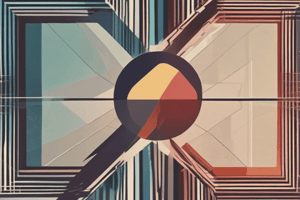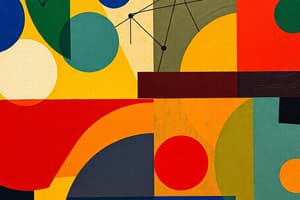Podcast
Questions and Answers
A shape is a three-dimensional object with depth, width, and height.
A shape is a three-dimensional object with depth, width, and height.
False (B)
Geometric shapes include irregular forms that resemble natural objects.
Geometric shapes include irregular forms that resemble natural objects.
False (B)
Positive space in art refers to the background surrounding a shape.
Positive space in art refers to the background surrounding a shape.
False (B)
Organic forms can be associated with living things and tend to mimic their characteristics.
Organic forms can be associated with living things and tend to mimic their characteristics.
The volume of a form is the space it occupies in three-dimensional art.
The volume of a form is the space it occupies in three-dimensional art.
Shapes and forms have no impact on the overall composition of an artwork.
Shapes and forms have no impact on the overall composition of an artwork.
The relationship between shape and form is solely based on their definitions.
The relationship between shape and form is solely based on their definitions.
Mass refers to the physical bulk of a form, which can be actual or implied.
Mass refers to the physical bulk of a form, which can be actual or implied.
Flashcards are hidden until you start studying
Study Notes
Elements of Arts: Shape and Form
Shape
- Definition: A two-dimensional area defined by a boundary or an outline.
- Types:
- Geometric Shapes: Regular, defined shapes (e.g., circles, squares, triangles).
- Organic Shapes: Irregular, free-form shapes resembling natural forms.
- Characteristics:
- Edges: Shapes have clear boundaries (can be outlined or filled).
- Positive and Negative Space: Positive shapes are the main focus; negative space is the background or area around shapes.
- Function:
- Creates visual interest and can guide the viewer's eye.
- Used to convey emotions or themes in art.
Form
- Definition: A three-dimensional object that has depth, width, and height.
- Types:
- Geometric Forms: Such as cubes, spheres, and pyramids.
- Organic Forms: Natural, irregular forms that mimic living things.
- Characteristics:
- Volume: The amount of space a form occupies.
- Mass: The physical bulk of a form; can be actual (solid) or implied (suggested by shading).
- Function:
- Adds depth and realism to artwork.
- Can create a sense of movement and dynamic composition.
Relationship between Shape and Form
- Interaction: Shapes can be combined or manipulated to create forms.
- Perspective: Different viewpoints can alter the perception of shape and form.
- Representation: The transition from shape to form enhances the visual narrative of the artwork.
Importance in Art
- Shapes and forms are foundational elements that contribute to composition, structure, and overall impact of an artwork.
- Understanding the distinction and interplay between them aids in both creating and analyzing art.
Shape
- A two-dimensional area defined by a boundary or outline.
- Geometric Shapes: Regular shapes such as circles, squares, and triangles that are mathematically defined.
- Organic Shapes: Irregular shapes that resemble the forms found in nature, offering a more free-form aesthetic.
- Edges: Shapes feature distinct boundaries that can be outlined or filled, impacting visual perception.
- Positive and Negative Space: Positive shapes are focal points, while negative space refers to the background or areas surrounding these shapes.
- Functions to generate visual interest and can direct the viewer's attention, also conveying emotions or themes in artistic works.
Form
- A three-dimensional object characterized by depth, width, and height.
- Geometric Forms: Includes regular shapes like cubes, spheres, and pyramids.
- Organic Forms: Represent irregular forms inspired by living organisms, emphasizing a naturalistic quality.
- Volume: Indicates the tangible space a form occupies in three dimensions.
- Mass: Refers to the physical bulk of a form, which can be actual (solid) or implied (suggested through shading techniques).
- Functions to introduce depth and realism in artwork, enhances dynamic compositions and conveys movement.
Relationship between Shape and Form
- Shapes can be combined or altered to develop three-dimensional forms, illustrating a creative interaction.
- Perspective: The viewer's position can change the perception and interpretation of both shape and form in visual art.
- The transition from two-dimensional shapes to three-dimensional forms enhances the narrative quality of artwork, strengthening communication of ideas.
Importance in Art
- Shapes and forms are fundamental elements essential for composition, structural integrity, and the overall impact of artistic pieces.
- Recognizing the nuances and interactions between shapes and forms improves both the creation and analysis of artwork, fostering a deeper understanding of visual expression.
Studying That Suits You
Use AI to generate personalized quizzes and flashcards to suit your learning preferences.




